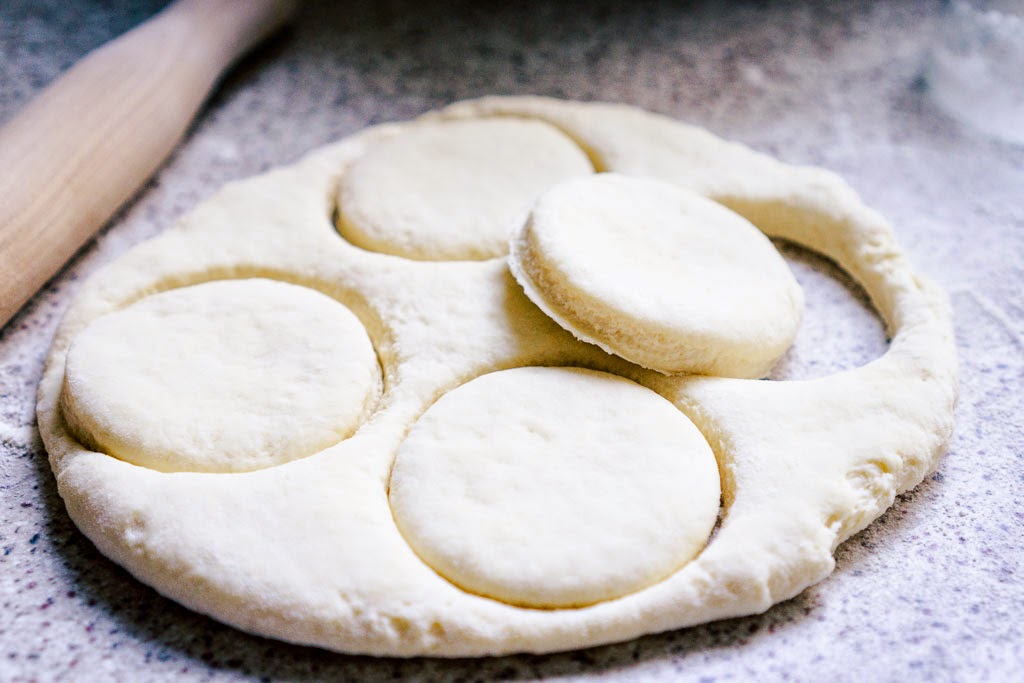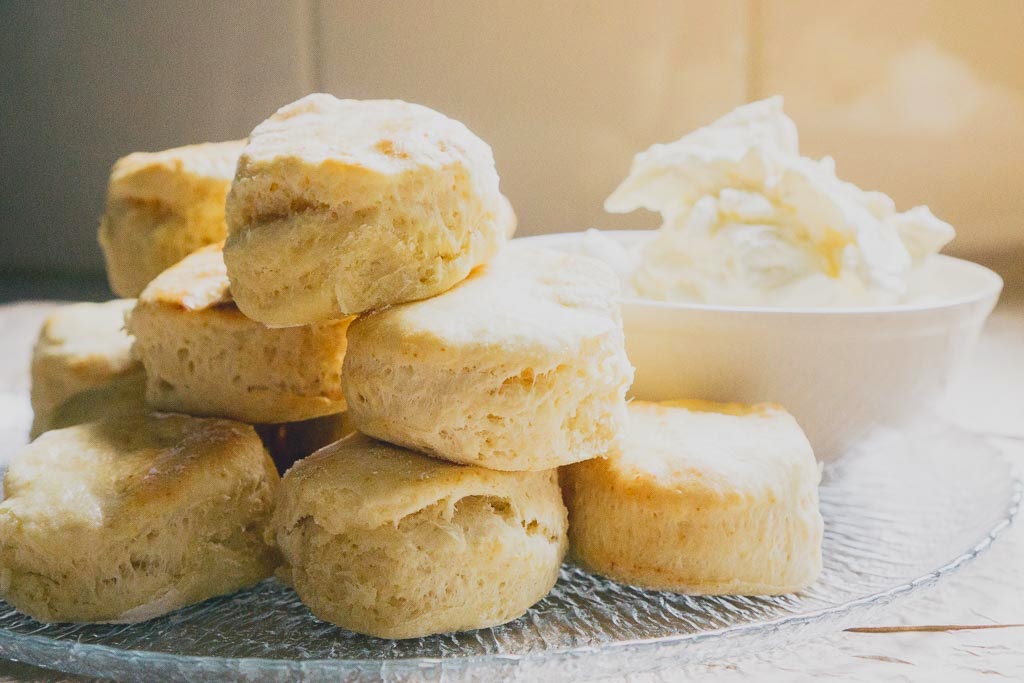Nothing makes a better afternoon tea companion than scones. It's light and fluffy texture paired with simple jam and cream is a classic loved by many people around the world. Scones have been a staple afternoon tea treat in my life for years. As a lover of scones, I have tried making them all. Buttermilk scones, lemonade scones, cheese scones, pumpkin scones etc. Almost every recipe out there offers the creation the perfect light and fluffy scone. So -- what happens when all you want is that simple fluffy buttery scone that tastes great with jam and cream? One that is quick to whip up and goes into your tummy even quicker? How do you sort out the 'classics' from the 'traditional', the 'lemonade' from the 'soda'?
Whilst it might not be the 'perfect' scone recipe, this personal favourite fail-safe recipe is one I have been using for years and it always produces light, fluffy and buttery scones that melt in your mouth. It is a crowd pleaser (I often make these to take into work when I start on a project to make new friends, it works!) and H is a big fan of these scones too as he will often eat four in one sitting. It provides the perfect base for your favourite jams and cream, I love mine with raspberry for that extra tart kick and of course, with a nice cup of tea.
Like all recipes, it is a personal preference on how you choose to tackle a recipe but to produce the scones I love to make and eat, I follow the use of ingredients in the recipe and observe a few simple additional rules when making and eating my scones.
1. Use chilled butter. Not room temperature
This creates that perfect incorporation of the flour and butter to create that lovely crumb.
2. Always use a metal knife to cut through the dough
Because of the chilled butter, I prefer to mix my milk (straight from the fridge!) and my flour/butter mix with a knife. I do not stir with the knife but rather use a form of cutting motion to cut through the flour mix, introducing milk in small portions then slowly scraping the sides, cutting in all the dry ingredients so it is well mixed with the milk. This also assists in reducing the "over-mixing" that often results in a dry dough.
3. Twice is enough
4. Scones love rising UP together!
I often see scone recipes calling for a 1cm space between each scone rounds but I discovered that the scones really love rising together. (throw away the ruler) Putting the rounds close together allows them to rise to the same height almost always and produce evenly cooked scones everytime. If you have had trouble rising scones (if they rise outwards...) as they bake, I would highly suggest putting them side by side, shoulder to shoulder. Together they will rise fluffy and delicious :)
5. Brush milk over the scones
To get that golden colour on the tops of your scones and to keep the moisture of your scones, I would strongly recommend brushing your scones with milk rather than dusting it with flour.
6. Always pull open a scone
I once stumbled across a lovely Tudor inspired cafe during my travels and the lovely English gentleman who made me the most AMAZING scones I have ever tasted in my life imparted a useful and most treasured tip when eating scones. The knife is for the jam/cream. NOT for cutting the scone open. As a scone requires minimal kneading, it pulls apart very naturally and often rises with a mid-section ready to be pulled apart. Cutting the soft dough with a cold knife will ultimately reset the dough back into its wet form and you will get a less even and fluffy scone when eating it. It is a minor tip but ever since I put down the knife and pulled open a scone, I have never looked back.
Wishing all of you a very happy Wednesday! I hope the sun is shining somewhere in the world today because it is COLD and gloomy in Melbourne. (more reasons to rug up with a cup of tea and warm fresh from the oven scones with jam and cream)
x Lynnette
The kind of scones I like are simple. Buttery, soft and light. No sugar added (there is jam for this exact reason...) Most of the time, I make them because I have the ingredients right there in my fridge and pantry. These are the kind of scones that smell so aromatic, that when it comes out of the oven that I can't resist eating the first scone out without the jam and cream. YUM!
Whilst it might not be the 'perfect' scone recipe, this personal favourite fail-safe recipe is one I have been using for years and it always produces light, fluffy and buttery scones that melt in your mouth. It is a crowd pleaser (I often make these to take into work when I start on a project to make new friends, it works!) and H is a big fan of these scones too as he will often eat four in one sitting. It provides the perfect base for your favourite jams and cream, I love mine with raspberry for that extra tart kick and of course, with a nice cup of tea.
Like all recipes, it is a personal preference on how you choose to tackle a recipe but to produce the scones I love to make and eat, I follow the use of ingredients in the recipe and observe a few simple additional rules when making and eating my scones.
1. Use chilled butter. Not room temperature
This creates that perfect incorporation of the flour and butter to create that lovely crumb.
2. Always use a metal knife to cut through the dough
Because of the chilled butter, I prefer to mix my milk (straight from the fridge!) and my flour/butter mix with a knife. I do not stir with the knife but rather use a form of cutting motion to cut through the flour mix, introducing milk in small portions then slowly scraping the sides, cutting in all the dry ingredients so it is well mixed with the milk. This also assists in reducing the "over-mixing" that often results in a dry dough.
3. Twice is enough
The golden rule when it comes to bringing the dough together is to remember that as soon as it is well mixed, you stop and start cutting the soft dough. With that theory, I prefer to only re-use/re-knead my off cuts of dough a maximum of two times.
A third knead often leads to a firm dough, if you wanted to test the theory you could knead the off cuts dough a third time and bake it in a corner where you will remember to compare. The first and second will be soft, fluffy and buttery and the third knead be a little firmer, dry and less packed with buttery goodness.4. Scones love rising UP together!
I often see scone recipes calling for a 1cm space between each scone rounds but I discovered that the scones really love rising together. (throw away the ruler) Putting the rounds close together allows them to rise to the same height almost always and produce evenly cooked scones everytime. If you have had trouble rising scones (if they rise outwards...) as they bake, I would highly suggest putting them side by side, shoulder to shoulder. Together they will rise fluffy and delicious :)
5. Brush milk over the scones
To get that golden colour on the tops of your scones and to keep the moisture of your scones, I would strongly recommend brushing your scones with milk rather than dusting it with flour.
6. Always pull open a scone
I once stumbled across a lovely Tudor inspired cafe during my travels and the lovely English gentleman who made me the most AMAZING scones I have ever tasted in my life imparted a useful and most treasured tip when eating scones. The knife is for the jam/cream. NOT for cutting the scone open. As a scone requires minimal kneading, it pulls apart very naturally and often rises with a mid-section ready to be pulled apart. Cutting the soft dough with a cold knife will ultimately reset the dough back into its wet form and you will get a less even and fluffy scone when eating it. It is a minor tip but ever since I put down the knife and pulled open a scone, I have never looked back.
I really loved photographing these fluffy scones. They are incredibly photogenic but also just delicious! I took these photos very quickly before I honed in and ate two scones with my cuppa. (following the 'sample' naked scone, I ate as soon as they came out of the oven... oink oink!)
x Lynnette














0 comments